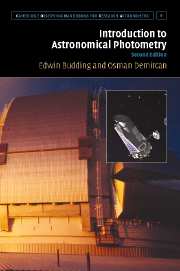Book contents
- Frontmatter
- Contents
- Preface to first edition
- Preface to second edition
- 1 Overview
- 2 Introduction
- 3 Underlying essentials
- 4 Themes of astronomical photometry
- 5 Practicalities
- 6 Procedures
- 7 Basic light curve analysis
- 8 Period changes in variable stars
- 9 Close binary systems
- 10 Spotted stars
- 11 Pulsating stars
- Appendix
- Author index
- Subject index
Preface to first edition
Published online by Cambridge University Press: 13 August 2009
- Frontmatter
- Contents
- Preface to first edition
- Preface to second edition
- 1 Overview
- 2 Introduction
- 3 Underlying essentials
- 4 Themes of astronomical photometry
- 5 Practicalities
- 6 Procedures
- 7 Basic light curve analysis
- 8 Period changes in variable stars
- 9 Close binary systems
- 10 Spotted stars
- 11 Pulsating stars
- Appendix
- Author index
- Subject index
Summary
The book which follows has grown out of my experiences in carrying out and teaching optical astronomy. Much of the practical side of this started for me when I was working with Professor M. Kitamura at what is now the National Astronomical Observatory of Japan, Mitaka, Tokyo, in the mid seventies. Having already learned something of the theoretical side of photometric data analysis and interpretation from Professor Z. Kopal in the Astronomy Department of the University of Manchester, when I later returned to that department and was asked to help with its teaching programme I started the notes which have ultimately formed at least part of the present text. I then had the pleasure of continuing with observing at the Kottamia Observatory, beneath the beautiful desert skies of Egypt, in the days of Professor A. Asaad, together with a number of good students, many of whom have since gone on to help found or join university departments of their own in different lands of the world.
In recent years – particularly since moving to Carter Observatory – another dimension has been added to my experience through my encounters with that special feature of the astronomical world: the active amateur! In previous centuries many creative scientists were, in some sense, amateurs, but in the twentieth century the tide, for fundamental research at least, has been very much in the direction of government, or other large organization, supported professionals, no doubt with very persuasive reasons.
- Type
- Chapter
- Information
- Introduction to Astronomical Photometry , pp. xi - xivPublisher: Cambridge University PressPrint publication year: 2007

